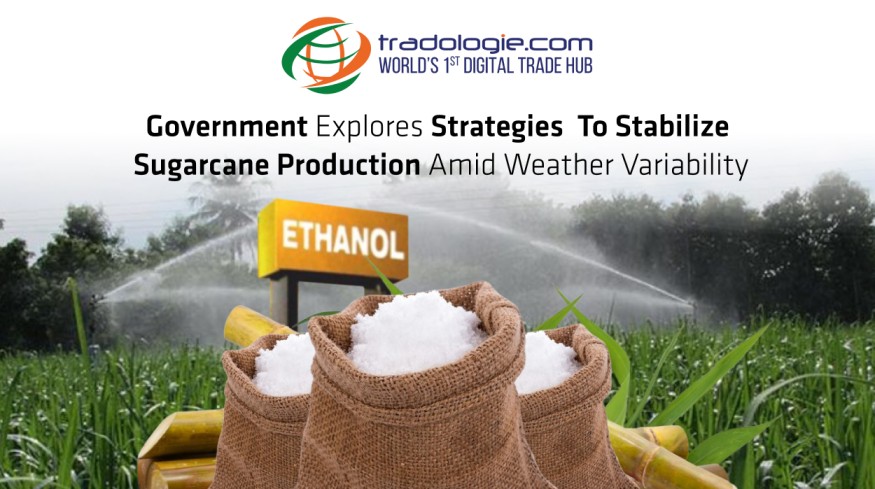 info@tradologie.com
info@tradologie.com
 +91 85959 57412
+91 85959 57412
 info@tradologie.com
info@tradologie.com
 +91 85959 57412
+91 85959 57412
The Indian government, in collaboration with the Indian Sugar and Bio-Energy Manufacturers Association (ISMA) and the National Federation of Cooperative Sugar Factories (NFCSF), is actively seeking solutions to stabilise sugarcane production. This effort aims to address the challenges posed by poor irrigation facilities and depleting water levels in key reservoirs, which are crucial for meeting domestic consumption needs and the ethanol blended with petrol (EBP) targets.
It’s quite evident that the government is bent to cater to the domestic demands as against the international. For buyers looking to Import Sugar in Bulk from India, things aren’t that promising. However, Tradololgie.com can facilitate its procurement process through many other countries and its reliable suppliers.
El Nino has significantly affected monsoon rainfall, leading to prolonged dry spells, particularly in major sugarcane-growing states such as Maharashtra, Karnataka, and Tamil Nadu. The inadequate rainfall has also resulted in the drying up of the country’s 150 major reservoirs, especially in the southern regions where water levels in 42 reservoirs have dropped to as low as 14% of their capacity.
Current Production Estimates In the ongoing 2023-24 season (October-September), India is estimated to produce 32 million tonnes (mt) of sugar after diverting 2.38 mt to ethanol, compared to 32.9 mt last year. Key sugarcane-producing states include Maharashtra, Uttar Pradesh, Karnataka, Gujarat, and Tamil Nadu. The government's efforts to stabilise production are critical, especially in the face of uncertain weather conditions that threaten crop output.
To combat food inflation, the government has implemented several preventative measures, including an indefinite sugar export ban. This initiative is crucial as the government aims to achieve its E20 target, which involves 20% ethanol blended with petrol, by 2025-26. Achieving this target requires a stable and sufficient supply of sugarcane for ethanol production.
As mentioned before, this might not be quite favourable for Indian sugar traders. However, Tradologie.com being a next generation B2B SaaS platform, can facilitate its bulk buying and selling through several alternate channels. It has an extensive network of global sugar exporters, who can cater to the bulk B2B demands.
India needs approximately 29 mt of sugar annually, with an annual growth rate of 1.5-2%. According to Niti Aayog, to meet the E20 target by 2025-26, the country needs 9.88 billion litres of ethanol, with 55% coming from sugarcane. However, El Nino has caused productivity to fall in drought-prone areas, which account for about 25-26% of the total planted area of 5.7 million hectares (mh).
Sugarcane cultivation requires year-round irrigation, making it crucial to augment irrigation resources and encourage drip irrigation systems. These measures are essential to overcome production fluctuations and ensure a stable ethanol supply after meeting domestic consumption needs. In 2021-22, sugarcane production reached 46.1 mt but dropped due to the adverse effects of El Nino.
To meet domestic consumption and the E20 target, sugarcane production must increase from the current productivity of 76 tonnes per hectare (ha) to 83 tonnes per ha over the next five years. Additionally, the area under sugarcane cultivation needs to expand from 5.7 mh to 6.2 mh to achieve a production target of 51 mt.
A committee comprising industry members from ISMA and NFCSF has been formed to advise the government on creating a sustainable plan. This plan aims to build a farmer-centric pro-energy transition ecosystem, aligning with the government’s vision for a bio-led energy transition in the country. ISMA Director General Deepak Ballani stated that proposals have been sent to the Department of Food and Public Distribution.
The proposal includes implementing five schemes across different ministries, such as Per Drop More Crop, Watershed Development-PMKVY 2.0, Crop Residue Management, mechanisation under the Sub-mission on Agricultural Mechanization, and the National Agricultural Development Programme. These schemes target key producing states, particularly for sugar farmers. The estimated financial outlay for the National Mission on Sugarcane over five years up to 2028-29 is nearly ₹38,000 crore.
The food ministry is currently examining the proposal, considering economic viability before finalising any decisions. The government is committed to addressing irrigation issues and stabilising sugarcane production to meet both domestic consumption and the EBP targets. While the process is still in the conceptual stage, efforts are underway to ensure sustainable production in the face of changing weather conditions.
If you want to export or Sugar Exporters, Tradologie.com is the best B2B platform. It facialites the bulk transactions without any middlemen through its state-of-the-art SaaS platform.
Visit www.tradologie.com to explore B2B export opportunities and stay updated with the latest trends in the industry.
To register as a buyer, click here. To register as a seller, click here.
